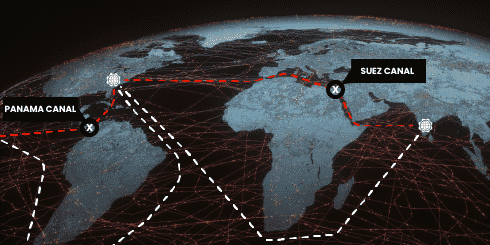10 Ways COVID Is Still Impacting Our Lives Today


COVID-19. Unfortunately, we were wrong about it. COVID is still here, and it doesn’t look like it’s going away anytime soon.
Throughout the pandemic, we blogged about how our teams were handling transitions and staying engaged to enable the all-important flow of goods through various countries to our warehouses in the U.S., Europe, and Mexico.
Then came the vaccines and normalizing of trade, so when the increases in container costs doubled from its previous 10-year average, we thought it was just a temporary blip on the road to “normal.” Nope. We were wrong about that.
Most consumers and businesses do not realize how much COVID continues to impact our lives!
The proof is in some of the data we’ve uncovered (reference links at the bottom for data):
1.) The worldwide vaccination rate is showing a steady increase, with about 4.58 billion people who’ve been vaccinated. This is a staggering achievement for all of us, thanks to the outstanding efforts of healthcare workers everywhere. But a better way to look at the number is by dose per 100 people. Right now, the U.S. stands at 106 million doses (52 million people). That means, as a nation, we’re under 50% for one dose and just below 60% for full vaccination. Experts believe we can expect only a marginal increase beyond these rates.
2.) COVID cases are near historic highs. New cases reported in August are north of 600,000 per day, which is not much different than the highest cases reported in December 2020/January 2021 of around 800,000 per day. One encouraging thing about new cases in the U.S., however, is that there seems to be a less severe effect on those who contract the virus, along with a reduced fatality rate.
3.) Countries are in shutdown and lockdowns are as stringent as they were in March/April 2020 at the outset of the pandemic. Vietnam’s had local lockdown for almost two months and India was in lockdown for about six weeks through June. Cases are flaring up in various parts of China with shutdowns in Shenzhen port in July and Ningbo port in August.
4.) Trade to the U.S. has skyrocketed this year with most U.S. ports (Los Angeles, New York, Seattle, Savannah, etc.) seeing traffic not experienced for decades. Los Angeles experienced a historic high with more than 11 million TEU (20’ equivalent containers) processed in May and June.
5.) There is a crisis building with seafarers. There are about a million seafarers, which operate some 60,000 ocean vessels at any given time. As of December 2020, an estimated 400,000 seafarers were stranded on ships beyond the 11-month maximum stipulated in their contracts. As of April 2021, there were an estimated 200,000 seafarers still stranded. More recent estimates are not available, but the disruption continues with respect to how many seafarers are available to operate the boats that are required to move the goods. This is the equivalent of waiting at an airport for flight attendants and pilots to arrive. It’s frustrating, unproductive, and always results in delays.
6.) There’s a shipping container problem. It’s not that there aren’t enough of them in the world, it’s just that they’re in the wrong locations. When the pandemic hit, there was less demand in the U.S. and other countries, so port authorities were struggling with having the resources to load and unload the containers. Vessel carriers chose to go back empty to Asian countries reportedly to save time and delays in loading the empty containers onto ships. But as demand went up, these containers were stuck outside ports and at various rail yards in Chicago, Kansas, and a host of other collection points. Union Pacific shut down any transfers through their Chicago hub in July, so they could take care of emptying their yards of containers and move them to production countries in Asia. Other train services also are showing signs of slowing down as recently as late July.
7.) There are ongoing port and evergreen issues. Ships were seriously delayed during European transits, thanks to the Evergreen ship that blocked the Suez Canal in early summer 2021. Since then, Yantian port (Shenzhen) was shut down for almost a week in June due to COVID cases. One of the main terminals (Meidong) in the Ningbo port was shut down just last week. For perspective, Meidong is the world’s third-largest port, processing some 7 million containers each year. Shutting it down by one week means holding up almost 150,000 containers! It’s an even larger number when the world needs to increase transfers. In addition, both Vietnam ports and trucking to the ports have been down drastically for almost six weeks.
8.) In-country travel restrictions continue. Our teams in Vietnam and India have been restricted from traveling outside their own states and regions for 2+ months. Conditional travel for essential services is allowed, but not encouraged. Most businesses are still in work-from-home mode with stringent mask mandates in Mexico, Taiwan, and other countries.
9.) Container prices from China to the U.S. have gone up four to five times their normal rate. Typical containers, which cost $3,000 from Shanghai to Los Angeles now cost almost $15,000. Because containers are stuck in different parts of the world, most carriers are now only booking port-to-port, so it’s up to customers or importers to book trucks separately from Los Angeles or Seattle (costing $6,000 or so in trucking cost from those ports to the Midwest warehouses). Costs from Shanghai to Europe have been as high as $30,000 – that’s seven times the normal rate. Further, the Drewry Index is at its historic high and going up incessantly for the past three months.
10.) The world will continue to experience delays galore. It’s not unusual for containers from any part of the world to any other part to see delays of seven or more days.
There is no doubt that Coronavirus disease (COVID-19) and the Delta variant are still around. While the U.S. population is seeing less of it, the movement of goods around the world continues to be severely hampered. Most experts believe container and shipping issues will continue through October and February Chinese New Year. Semi-conductor delays, however, may continue for the better part of 2022.
Our hope is that vaccinations continue to at a feverish pace and that new mutations of the virus are not as severe as the Delta variant.
Finally, we do hope that this is our last writing on COVID. Fingers crossed …
References:
https://www.nytimes.com/interactive/2021/world/covid-vaccinations-tracker.html
https://ourworldindata.org/covid-vaccinations
https://qz.com/2027205/a-shipping-container-shortage-is-snarling-global-trade/




